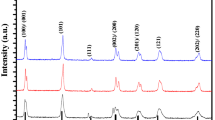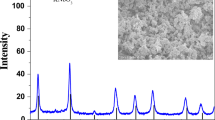Abstract
The method of preparation and its processing parameters have a strong effect on the structure and non-linear properties of the materials. A sol–gel technique is highly favoured owing to its lower production temperature, nanoparticle size, inter-diffusion of cations and cost-effectiveness. Sodium potassium niobate (KNN) is the most capable environmentally friendly material, which has been studied for the last decades as a promising candidate among all lead-free perovskites materials. In this article, we have prepared KNN ceramics by using the wet chemical sol–gel route. To control the volatility of (Na, K) ions at higher production temperature, we have added 10–20% (Na, K) alkali metal in the precursor solution. The phase investigation and crystalline character of the ceramics have been analysed by X-ray diffractometer. Raman spectroscopy analysis disclosed that pure KNN ceramic has a better crystalline and perovskite structure. FTIR analysis is done to analyse the presence of the functional group in the wavenumber range of 4000–500 cm−1. The surface microstructure analysis and morphology of the KNN ceramics have been studied by using field emission scanning electron microscopy techniques. Further, the optical and photoluminescence behaviour has been studied at room temperature to know its practical applications in various electro-optic device applications.















Similar content being viewed by others
References
Haertling G H 1999 J. Am. Ceram. Soc. 82 797
Baxter F R, Bowen C R, Tnrner I G and Dent A C E 2010 Ann. Biomed. Eng. 38 2079
Gupta V, Sharma M and Thakur N 2010 J. Int. Mater. Sys. Struct. 21 1227
Jiagang W, Dingquan X and Jianguo Z 2015 Chem. Rev. 115 2559
Bowen C R, Kim H A, Weaver P M and Dunn S 2014 Energy Environ. Sci. 7 25
Kumar S, Shandilya M, Thakur S, Thakur N and Kaur G A 2019 J. Sol-Gel Sci. Technol. 92 215
Panda P K 2009 J. Mater. Sci. 44 5049
Panda P K and Sahoo B 2015 Ferroelectrics 474 128
Yi L, Moon K and Wong C P 2005 Science 308 1419
Chen K, Zhou J, Zhang F, Zhang X, Li C and An L 2015 J. Am. Ceram. Soc. 98 1698
Safari A and Hejazi M 2012 in Lead-free piezoelectrics S Priya and S Nahm (eds) (New York, NY: Springer)
Kumar S and Thakur N 2019 J. Electron. Mater. 48 6203
Kumar S and Thakur N 2019 Bull. Mater. Sci. 42 135
Dolhen M, Mahajan A, Pinho R, Costa M E, Trolliard G and Vilarinho P M 2015 RSC Adv. 5 4698
Adachi S 1999 Optical properties of crystalline and amorphous semiconductors: materials and fundamental principles (Springer Science + Business Media, LLC)
Mandal S K, Rakshit T, Ray S K, Mishra S K, Krishna P S R and Chandra A 2013 J. Phys.: Condens. Matter 25 055303
Wang Z, Gu H, Hu Y, Yang K, Hu M, Zhoua D et al 2010 CrystEngComm 12 3157
Aydın C, Al-Hartomy O A, Al-Ghamdi A A, Al-Hazmi F, Yahia I S, El-Tantawy F et al 2012 J. Electroceram. 29 155
Choudhury B, Borah B and Choudhury A 2012 Photochem. Photobiol. 88 257
Park W D 2012 Trans. Electr. Electron. Mater. 13 196
Singh J, Verma V, Kumar R and Kumar R 2019 Results Phys. 13 102106
Elkorashy A M 1990 Phys. Status Solidi B 159 903
Moss T S, Burrell G J and Ellis E 2013 Semiconductor opto-electronics (London: Butterworth & Co. Ltd.)
Author information
Authors and Affiliations
Corresponding author
Supplementary Information
Below is the link to the electronic supplementary material.
Rights and permissions
Springer Nature or its licensor (e.g. a society or other partner) holds exclusive rights to this article under a publishing agreement with the author(s) or other rightsholder(s); author self-archiving of the accepted manuscript version of this article is solely governed by the terms of such publishing agreement and applicable law.
About this article
Cite this article
KUMAR, S., THAKUR, N. Effect of alkali metal (Na, K) ion ratio on structural, optical and photoluminescence properties of K0.5Na0.5NbO3 ceramics prepared by sol–gel technique. Bull Mater Sci 44, 51 (2021). https://doi.org/10.1007/s12034-020-02341-x
Received:
Accepted:
Published:
DOI: https://doi.org/10.1007/s12034-020-02341-x




